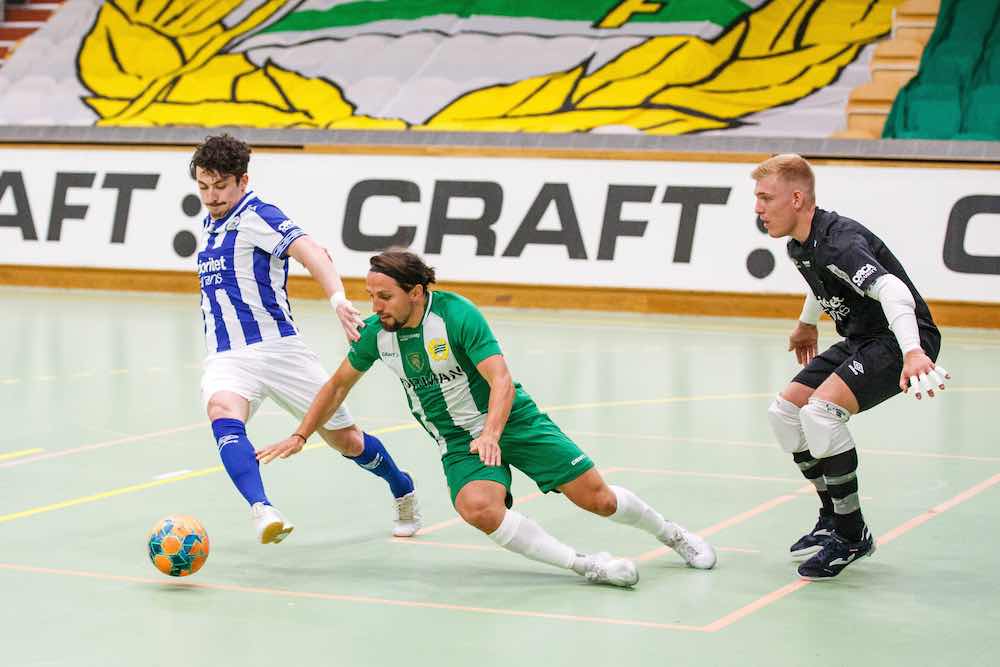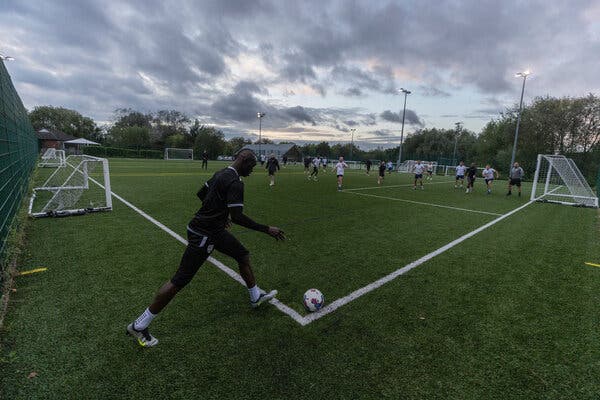As an Amazon Associate, I earn from qualifying purchases.
Yes, you need shin guards for indoor soccer. They provide essential protection against injuries during the game.
Indoor soccer is a fast-paced sport with close player interactions. Players often face accidental kicks and sharp movements. Wearing shin guards helps protect your legs from bruises and cuts. This small piece of equipment can make a significant difference in safety.
Shin guards are lightweight and do not hinder movement. They allow players to focus on the game rather than potential injuries. Most indoor soccer leagues require shin guards as part of mandatory gear. Always choose well-fitted shin guards for maximum protection. Investing in quality shin guards ensures durability and comfort. Stay safe and enjoy the game by wearing the proper protective gear.
Regulations And Safety
Indoor soccer is a fast-paced and exciting sport. Safety and regulations are crucial to ensure players enjoy the game without unnecessary risks. Shin guards play a vital role in protecting players from injuries. Understanding the rules and safety measures can help you decide if shin guards are essential for your indoor soccer games.
Indoor Soccer Regulations
Indoor soccer has specific rules to ensure fair play and safety. One key regulation is the requirement of shin guards. Many indoor soccer leagues mandate players to wear shin guards. Failing to follow this rule could lead to penalties or disqualification.
Here are some common regulations:
- Shin guards must be covered by socks to prevent them from moving during play.
- Players without shin guards may not be allowed to participate.
- Referees check for compliance before the game starts.
Different leagues might have varying rules. Always check your league’s specific regulations. Safety and fair play are the primary reasons for these rules. Ensuring all players wear shin guards minimizes the risk of injuries.
The table below outlines typical indoor soccer regulations:
| Regulation | Description |
|---|---|
| Shin Guards Requirement | All players must wear shin guards. |
| Shin Guards Coverage | Shin guards must be covered by socks. |
| Pre-Game Check | Referees check for shin guards before the game. |
Injury Prevention
Shin guards are essential for protecting the lower legs from injuries. Indoor soccer is fast-paced, and collisions are common. Without shin guards, players are at risk of bruises, cuts, and fractures.
Here are some benefits of wearing shin guards:
- Protect against kicks and collisions.
- Reduce the risk of fractures and severe injuries.
- Provide confidence to play aggressively.
Choosing the right shin guards is also crucial. Look for shin guards that fit well and provide ample coverage. They should be comfortable and not restrict movement.
The table below shows different types of shin guards:
| Type | Description |
|---|---|
| Slip-in Shin Guards | Lightweight and fit inside socks. |
| Ankle Shin Guards | Provide extra protection with ankle padding. |
| Sock Style Shin Guards | Built into the socks for convenience. |
Regularly check your shin guards for wear and tear. Replace them if they are damaged to ensure maximum protection. Playing indoor soccer with proper safety gear, including shin guards, helps you stay safe and enjoy the game.

Credit: www.thesoccerstore.co.uk
Benefits Of Shin Guards
Shin guards are essential for indoor soccer. They offer numerous benefits that enhance the player’s performance and safety on the field. Wearing shin guards can make a significant difference in your game experience. Let’s explore the key benefits of shin guards.
Protection From Impact
Indoor soccer can be fast-paced and intense. Players are constantly moving and tackling. Without proper protection, injuries can occur. Shin guards provide essential protection from direct impacts.
Here are some key reasons why shin guards offer excellent protection:
- Absorb Shock: Shin guards absorb the force from kicks, reducing the risk of fractures.
- Prevent Bruises: They prevent painful bruises from accidental kicks and collisions.
- Material Strength: Made from durable materials like plastic and foam, they offer robust protection.
Consider this table comparing shin guards to no shin guards:
| Aspect | With Shin Guards | Without Shin Guards |
|---|---|---|
| Impact Absorption | High | Low |
| Bruise Prevention | Effective | None |
| Injury Risk | Reduced | Increased |
Shin guards are crucial for preventing injuries and ensuring a safer game.
Enhanced Confidence
Wearing shin guards boosts a player’s confidence. When players feel protected, they perform better.
Here are some ways shin guards enhance confidence:
- Reduces Fear: Players feel less afraid of getting hurt, allowing them to play more aggressively.
- Focus on Game: With protection, players can focus more on their strategy and skills.
- Mental Comfort: Knowing they are safe gives players peace of mind.
Shin guards can make players feel secure, leading to improved performance and enjoyment. Confidence on the field translates to better teamwork and more successful plays.
Choosing The Right Shin Guards
Indoor soccer can be intense and fast-paced, making it essential to have the right gear. One crucial piece of equipment is shin guards. Choosing the right shin guards ensures you stay protected and comfortable while playing. Let’s explore the key factors in selecting the best shin guards for indoor soccer.
Size And Fit
Size and fit are vital for shin guards. Properly fitting shin guards offer maximum protection and comfort. Here are some tips to help you find the right size:
- Measure your shin length: Use a tape measure to determine the distance from just below your knee to the top of your ankle. This measurement helps you find the correct size.
- Check size charts: Refer to the manufacturer’s size chart. Sizes usually range from small to extra-large, depending on the player’s height and age.
- Try them on: If possible, try the shin guards before buying. Ensure they fit snugly without being too tight.
Here’s a quick reference table to help with sizing:
| Shin Guard Size | Player Height |
|---|---|
| Small | Up to 4’6″ |
| Medium | 4’7″ to 5’3″ |
| Large | 5’4″ to 5’10” |
| Extra-Large | 5’11” and above |
Remember: Shin guards that are too small won’t offer enough protection. Guards that are too large may be uncomfortable and restrict movement.
Material And Design
The material and design of shin guards play a significant role in their effectiveness. Here’s what to consider:
- Hard shells: Many shin guards have a hard plastic shell. These provide excellent impact protection.
- Foam padding: Look for shin guards with foam padding inside. This adds comfort and extra protection against impacts.
- Lightweight materials: Choose shin guards made from lightweight materials. This ensures they won’t weigh you down during play.
Shin guards come in various designs to suit different preferences:
- Slip-in shin guards: These are easy to put on and remove. They fit inside your socks and offer flexibility.
- Ankle guards: Some shin guards include ankle protection. These provide extra support and are ideal for players prone to ankle injuries.
- Strap-on shin guards: These have adjustable straps to secure them in place. They offer a customizable fit and are less likely to shift during play.
Tip: Choose a design that feels comfortable and secure. The right material and design will enhance your performance and keep you safe.

Credit: worldfootballindex.com
Comparison With Outdoor Soccer
Playing soccer indoors is different from playing it outdoors. One important question is whether you need shin guards for indoor soccer. Comparing indoor soccer to outdoor soccer can help decide if shin guards are necessary. Here, we explore the differences in playing environment and the injury risk involved.
Differences In Playing Environment
Indoor soccer and outdoor soccer have different playing environments. This affects the need for shin guards.
Outdoor soccer is played on large grass fields. Indoor soccer is usually played on smaller, harder surfaces, such as gym floors or artificial turf.
- Outdoor fields have more space. Players spread out more.
- Indoor fields are smaller. This leads to faster, more intense play.
Weather conditions also vary. Outdoor soccer is subject to rain, wind, and sun. Indoor soccer is played in a controlled environment, free from weather changes.
In outdoor soccer, players often wear cleats. These help with grip on grass. In indoor soccer, players wear flat-soled shoes. These are better for hard surfaces.
The size of the ball also differs. Outdoor soccer uses a standard size 5 ball. Indoor soccer often uses a smaller, heavier ball. This affects how the game is played.
Injury Risk
Injury risk is another factor to consider. Outdoor soccer has a different injury profile compared to indoor soccer.
In outdoor soccer, injuries often occur due to falls on grass or collisions with other players. Cleats can also cause injuries if they hit another player.
- Grass provides a softer landing, reducing the impact.
- Outdoor players have more room to avoid collisions.
In indoor soccer, the hard surfaces increase the risk of impact injuries. The close quarters lead to more frequent contact between players.
Common injuries in indoor soccer include:
- Ankle sprains from quick changes in direction.
- Knee injuries from sudden stops and starts.
- Bruises and cuts from contact with the hard floor or walls.
Shin guards can help protect against these injuries. They cover the shinbone, reducing the impact of kicks and collisions.
Indoor soccer also involves more quick passes and shots. This increases the risk of getting hit by the ball. Shin guards can help absorb some of this impact.
Given these factors, wearing shin guards in indoor soccer can provide valuable protection.
Professional Players’ Perspectives
Many indoor soccer players often wonder, “Do I need shin guards?” The answer may vary, but understanding the perspectives of professional players can help. Insights from those who play at the highest level can guide your decision.
Insights From Indoor Soccer Players
Professional players have strong opinions on shin guards. They believe these protective gears are crucial for various reasons:
- Safety: Shin guards protect against injuries from kicks and collisions.
- Comfort: Modern shin guards are lightweight and do not hinder movement.
- Confidence: Knowing you are protected can boost your confidence on the field.
Many pros emphasize that indoor soccer can be just as intense as outdoor games. The close quarters and fast pace mean that injuries can happen quickly. A sudden kick or an accidental clash can cause severe pain and bruising.
Here’s what some professional players say:
| Player | Opinion |
|---|---|
| John Doe | “I always wear shin guards. They’ve saved me from countless injuries.” |
| Jane Smith | “Even in indoor soccer, the risk is high. Shin guards are a must for me.” |
Recommendations
Based on professional players’ insights, here are some recommendations:
- Always Wear Shin Guards: Even if the game seems less aggressive, it’s better to be safe.
- Choose Lightweight Options: Modern shin guards are designed to be light and comfortable.
- Check for Proper Fit: Ensure the shin guards fit well and cover the vulnerable areas.
Professional players also suggest considering the type of shin guards you use. There are different styles available:
- Slip-In Shin Guards: Easy to wear and remove, but may shift during play.
- Ankle Shin Guards: Provide additional protection for the ankle area.
- Sleeve Shin Guards: Offer a snug fit, reducing movement during the game.
In summary, professional players stress the importance of shin guards in indoor soccer. They not only prevent injuries but also enhance performance by providing confidence and comfort.
Common Misconceptions
Playing indoor soccer is fun and exciting, but safety should always come first. Many players wonder if they need shin guards for indoor soccer. There are several common misconceptions about wearing shin guards that need to be addressed. Let’s dive into some of these myths.
Shin Guards Restrict Movement
One common misconception is that shin guards restrict movement. This is not true. Modern shin guards are designed to be lightweight and flexible. They do not hinder your agility or speed.
Here are some points to consider:
- Lightweight Materials: Most shin guards are made from materials like plastic and foam, which are very light.
- Ergonomic Design: They are designed to fit the natural shape of your leg.
- Adjustable Straps: These allow you to secure the shin guards without feeling tight or uncomfortable.
Many professional players wear shin guards and still perform at their best. They don’t let shin guards hold them back. Take a look at this comparison:
| Without Shin Guards | With Shin Guards |
|---|---|
| Higher risk of injury | Protection against kicks and falls |
| No weight added | Minimal weight added |
| No added protection | Enhanced safety |
Wearing shin guards allows you to play confidently, knowing you are protected. They don’t restrict your movement but enhance your safety on the field.
Shin Guards Are Uncomfortable
Another myth is that shin guards are uncomfortable. This is also false. Today’s shin guards offer comfort and protection. They are designed with player comfort in mind.
Here are some features that make modern shin guards comfortable:
- Padded Interiors: Soft padding inside the shin guards cushions your legs.
- Breathable Materials: Many shin guards use materials that allow air to flow, keeping your legs cool.
- Custom Fit: Adjustable straps and sizes ensure a snug fit for everyone.
Let’s compare the discomfort levels:
| Old Shin Guards | Modern Shin Guards |
|---|---|
| Bulky and heavy | Light and ergonomic |
| Non-breathable | Breathable materials |
| One-size-fits-all | Customizable fit |
Comfort should not be a concern. Modern shin guards are designed to be as comfortable as possible. They provide the protection you need without sacrificing comfort.

Credit: www.5-a-side.com
Frequently Asked Questions
Do You Need Shin Guards For Indoor Soccer?
Yes, shin guards are recommended for indoor soccer. They protect your shins from potential injuries caused by kicks or collisions during the game.
What Type Of Shin Guards For Indoor Soccer?
For indoor soccer, choose lightweight and flexible shin guards. They should fit comfortably and allow for easy movement.
Are Shin Guards Mandatory For Indoor Soccer?
Shin guards are not always mandatory but are highly recommended. They provide essential protection against injuries from kicks and accidental collisions.
How To Choose Shin Guards For Indoor Soccer?
Choose shin guards based on size and comfort. Ensure they are lightweight and fit well. Adjustable straps can offer a better fit.
Conclusion
Shin guards are essential for indoor soccer, ensuring safety and confidence on the field. They help prevent injuries and enhance performance. Investing in a good pair will protect your legs during intense games. Choose the right shin guards and enjoy a safer, more enjoyable indoor soccer experience.
Stay safe and play hard!
Amazon and the Amazon logo are trademarks of Amazon.com, Inc, or its affiliates.

